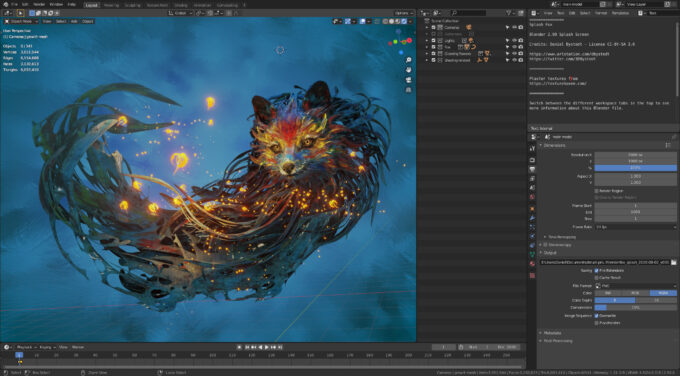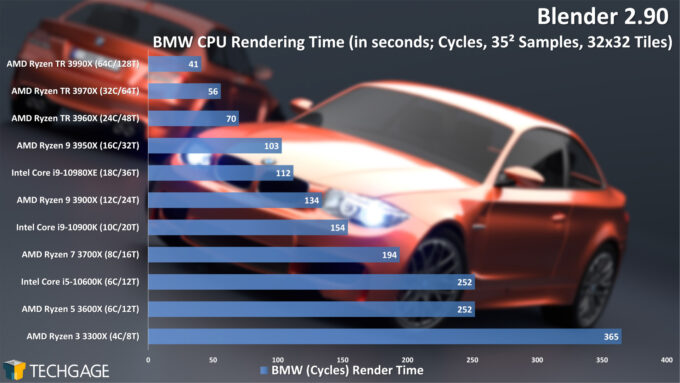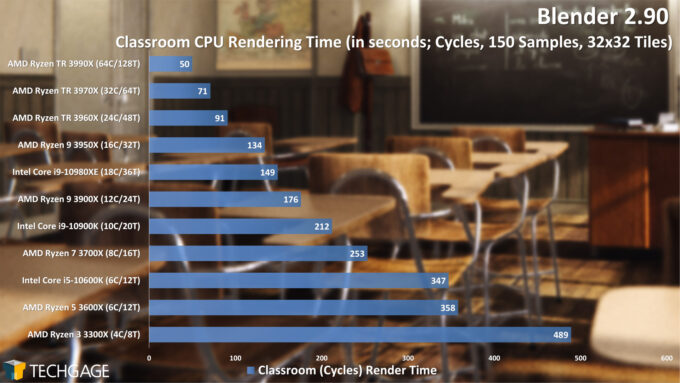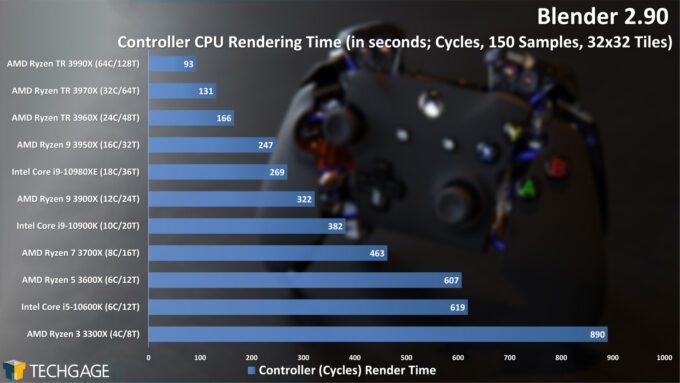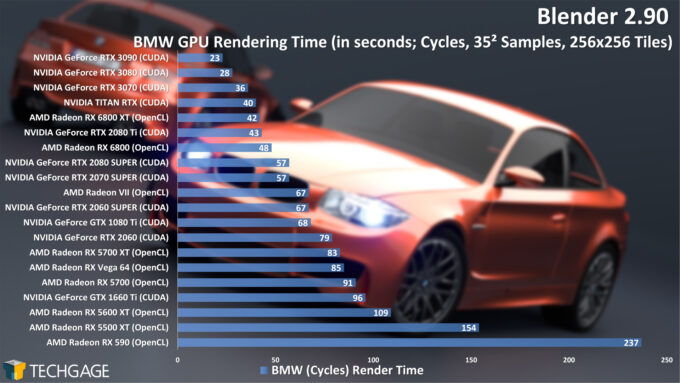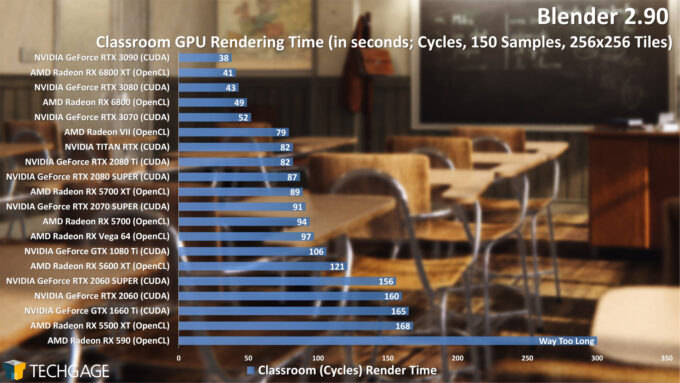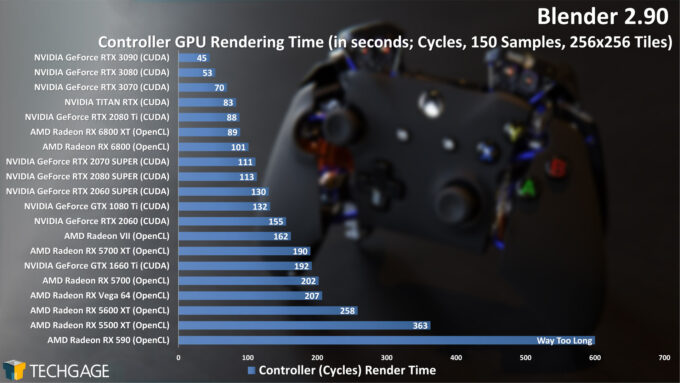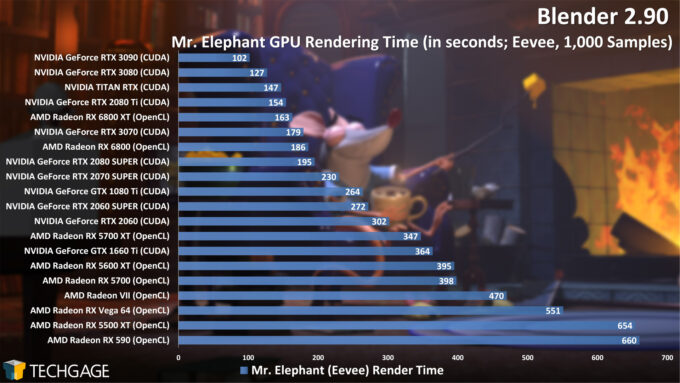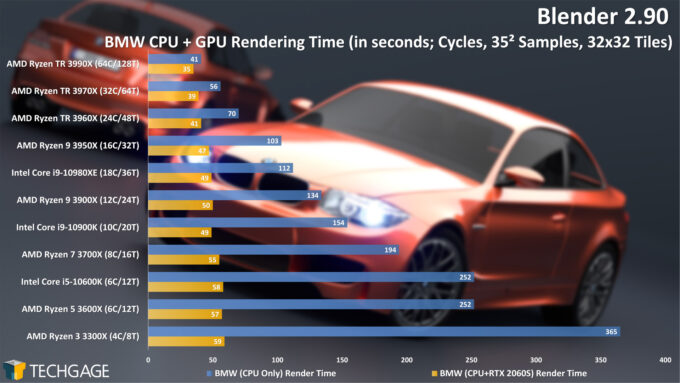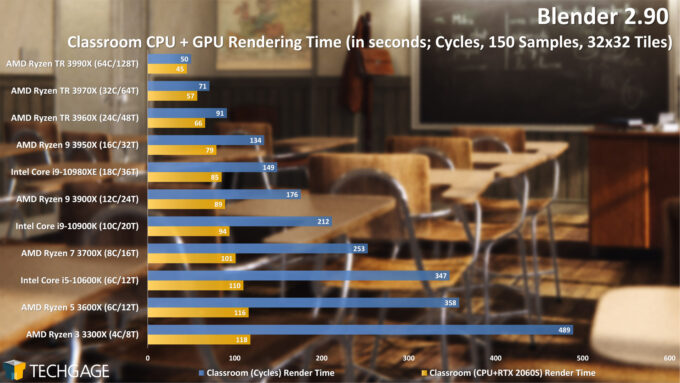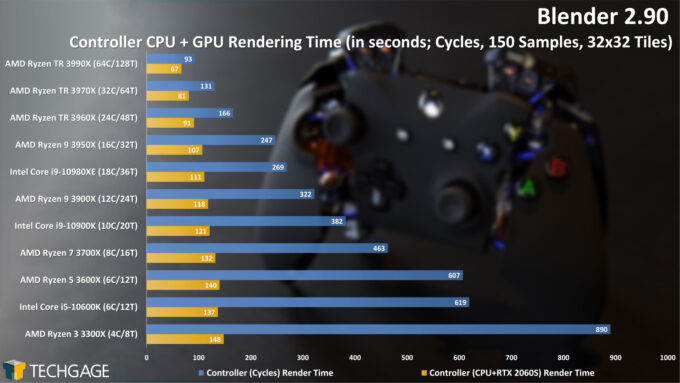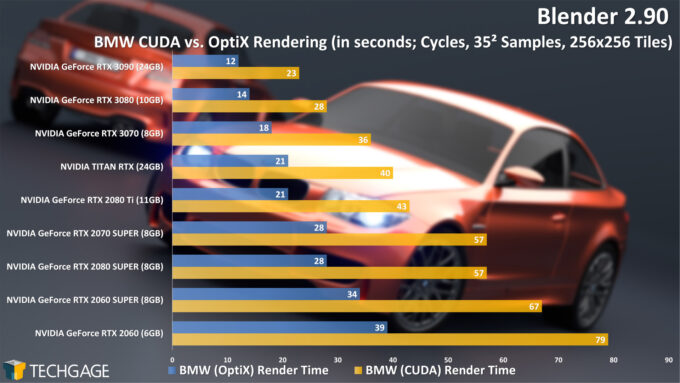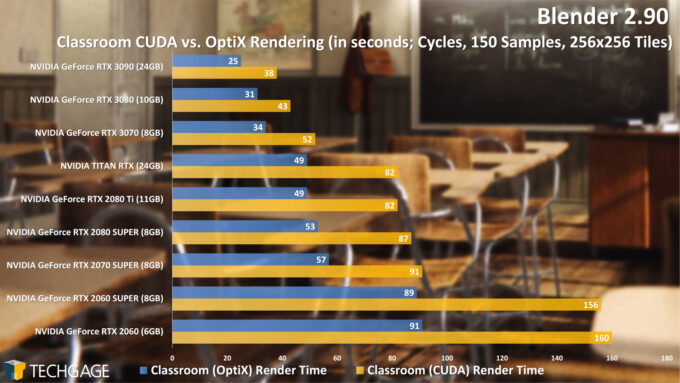- Qualcomm Launches Snapdragon 4 Gen 2 Mobile Platform
- AMD Launches Ryzen PRO 7000 Series Mobile & Desktop Platform
- Intel Launches Sleek Single-Slot Arc Pro A60 Workstation Graphics Card
- NVIDIA Announces Latest Ada Lovelace Additions: GeForce RTX 4060 Ti & RTX 4060
- Maxon Redshift With AMD Radeon GPU Rendering Support Now Available
Blender 2.90: Best CPUs & GPUs For Rendering & Viewport

With a collection of CPUs and GPUs, we’re exploring performance in the latest version of Blender, 2.90. As before, we’re going to take a look at rendering performance with both Cycles and Eevee, as well as hybrid and OptiX rendering. For good measure, we’ll also take a look at Material Preview viewport performance.
Page 1 – Rendering Performance (CPU, GPU, Hybrid & NVIDIA OptiX)
Get the latest GPU rendering benchmark results in our more up-to-date Blender 3.6 performance article.
Blender’s newest 2.90 version released two months ago, and for a couple of reasons, this performance overview has been lagged. Hassles in testing led to initial delays, and then other work came along and pushed production back further. We’ve continued to see reader request for this article, however, especially since the release of NVIDIA’s latest graphics cards – so here we are.
As we’ve done before, we’re going to be taking a look at both CPU and GPU rendering in Blender’s latest version, across both Cycles and Eevee render engines. We’ll also be taking a look at Material Preview viewport performance. As soon as 2.91 drops (link here), we’ll jump on retesting.
It’s unfortunate that Radeon is the reason this article was originally delayed. A bug in recent Adrenalin drivers will cause Blender to crash during multiple renders on either the RX 5700 or RX 5700 XT. For that reason, we had to test those cards on the older 20.5.1 driver from this past summer.
It’s disappointing to see this issue arise, because we’re dealing with GPUs that are over one year old, and they remain AMD’s current top-end choices. Yet, for the past four months, Blender will crash during a simple BMW project render, each and every time. Unless you downgrade to the 20.5.1 (and possibly 20.6.X driver). If you opt for Radeon for Blender use, bear in mind these potential issues.
Without wasting more time, here’s a look at all of the hardware being tested for this article:
| CPUs & GPUs Tested in Blender 2.90 |
| AMD Ryzen Threadripper 3990X (64-core; 2.9 GHz; $3,990) AMD Ryzen Threadripper 3970X (32-core; 3.7 GHz; $1,999) AMD Ryzen Threadripper 3960X (24-core; 3.8 GHz; $1,399) AMD Ryzen 9 3950X (16-core; 3.5 GHz; $749) AMD Ryzen 9 3900X (12-core; 3.8 GHz; $499) AMD Ryzen 7 3700X (8-core; 3.6 GHz; $329) AMD Ryzen 5 3600X (6-core; 3.8 GHz; $249) AMD Ryzen 3 3300X (4-core; 3.8 GHz; $120) Intel Core i9-10980XE (18-core, 3.0 GHz; $999) Intel Core i9-10900K (10-core; 3.7 GHz; $499) Intel Core i5-10600K (6-core; 3.8 GHz; $269) |
| AMD Radeon RX 6800 XT (16GB; $649) AMD Radeon RX 6800 (16GB; $579) AMD Radeon VII (16GB; $EOL) AMD Radeon RX 5700 XT (8GB; $399) AMD Radeon RX 5700 (8GB; $349) AMD Radeon RX 5600 XT (6GB; $279) AMD Radeon RX 5500 XT (8GB; $199) AMD Radeon RX Vega 64 (8GB; $EOL) AMD Radeon RX 590 (8GB; $199) NVIDIA RTX 3090 (24GB, $1,499) NVIDIA RTX 3080 (10GB, $699) NVIDIA RTX 3070 (8GB, $499) NVIDIA TITAN RTX (24GB; $2,499) NVIDIA GeForce RTX 2080 Ti (11GB; $1,199) NVIDIA GeForce RTX 2080 SUPER (8GB, $699) NVIDIA GeForce RTX 2070 SUPER (8GB; $499) NVIDIA GeForce RTX 2060 SUPER (8GB; $399) NVIDIA GeForce RTX 2060 (6GB; $349) NVIDIA GeForce GTX 1080 Ti (11GB; $EOL) NVIDIA GeForce GTX 1660 Ti (6GB; $279) |
| Motherboard chipset drivers were updated on each platform before testing. All chips were run with DDR4-3200 16GBx4 Corsair Vengeance. All GPU testing was done with our Intel Core i9-10980XE workstation. AMD Radeon Driver: Adrenalin 20.8.3 (20.5.1 for RDNA, 20.45.01.12 beta for RDNA2) NVIDIA GeForce & TITAN Driver: GeForce 451.77 All product links in this table are affiliated, and support the website. |
CPU Rendering
Because GPUs have become so powerful, the CPU is arguably not going to be an important decision for most people. If you want a CPU for rendering, you really need to opt for a model with as many cores as you can afford, since Blender does a great job of scaling up. With Cycles, however, high-end GPUs will match the performance of top-end CPUs easily.
With Cycles, we’ve seen (and will see again) that NVIDIA’s OptiX acceleration can dramatically improve performance, which is something really hurting Radeon prospects as well (if the driver hassles weren’t enough). Eevee, by contrast, only uses the GPU. If you want a fast CPU but don’t care about using it for rendering, you’ll want to prioritize clock speed.
A CPU like AMD’s $329 Ryzen 7 3700X or Intel’s $379 Core i9-10700K would make for a great choice, although if you are on a budget, the 6-core models should fit the bill just fine, as well.
GPU (CUDA & OpenCL) Rendering
From the get-go, NVIDIA’s latest GPUs have proven themselves a force to be reckoned with. NVIDIA promised that the RTX 3070 would be as fast as the 2080 Ti, and while punches are traded often on the gaming side, it’s almost always better in rendering. In each of the three render tests above, the $499 GeForce RTX 3070 outperformed even the TITAN RTX, not just 2080 Ti.
It’s always been intriguing that the Radeon VII performs so well in the Classroom render vs the other projects, but now that we’ve been able to add the Radeon RX 6800 series to the mix, we can see that some of those strengths have carried over to AMD’s newest cards. Unfortunately for team red, NVIDIA’s Ampere proves a lot stronger than the previous generation Turing, and this is before we see accelerated ray tracing with OptiX.
Here’s some Eevee performance:
It’s clear that NVIDIA doesn’t see as large a performance boost in Eevee as it does with Cycles, although its parts are powerful enough to soar to the top, anyway. Here, the RTX 3070 actually fell behind the RTX 2080 Ti, although not by too much. The RTX 3090 really stands out, pushing well ahead of the RTX 3080. It seems that Eevee really likes fast memory, and the more of it, the better.
With regards to AMD’s new RX 6800 series, we can see huge performance gains in Eevee, when compared to the last-gen RX 5700 series. The 6800 XT sits behind the last-gen 2080 Ti, but both it and the RX 6800 make a sandwich out of the RTX 3070.
Heterogeneous Rendering
CPU + GPU hybrid rendering has been good for quite some time in Blender, although since the introduction of NVIDIA’s ray tracing acceleration, it’s a little less lucrative than it used to be. Whereas the 64-core Ryzen Threadripper 3990X and 2060 SUPER rendered BMW in 39 seconds, we’ll see next that OptiX on a modest RTX 2060 can do it in the exact same time. That said, if you don’t have a newer GPU, but do have a powerful CPU, you will definitely want to take advantage of hybrid rendering.
It’s worth noting that OptiX doesn’t offer 100% feature parity with the CUDA API at the moment, but that’s unlikely to be an issue for any modern projects that are built around OptiX from the start. Speaking of OptiX, let’s tackle that performance next:
NVIDIA OptiX Rendering
These results make it clear that NVIDIA’s OptiX API can make a huge improvement to Cycles render times. Normally, a fall from 52 to 34 seconds in a render would require an entirely different model product, but in the RTX 3070’s case, it’s a matter of enabling OptiX.
With AMD’s cards now tested, we can compare our earlier performance to here. The RX 6800 XT rendered the Classroom project in 41 seconds, which put it at the top of the chart. With OptiX engaged, the RTX 3080 settles at 31 seconds. That’s quite strong performance from the Radeon side nonetheless, although the Classroom project proves the most favorable towards it. The Controller project performance deltas are a bit wider.
As a reminder, OptiX acceleration doesn’t impact Eevee, so if you’re thinking about skimping to get a lower-end GPU because the OptiX RT is so good, bear in mind the Eevee scaling, as well as the amount of memory you’re going to have available. We’d highly encourage opting for GPUs with at least 8GB of memory nowadays.
We’re going to take a look at viewport performance on the next page, as well as try to draw up some conclusions.
Support our efforts! With ad revenue at an all-time low for written websites, we're relying more than ever on reader support to help us continue putting so much effort into this type of content. You can support us by becoming a Patron, or by using our Amazon shopping affiliate links listed through our articles. Thanks for your support!




